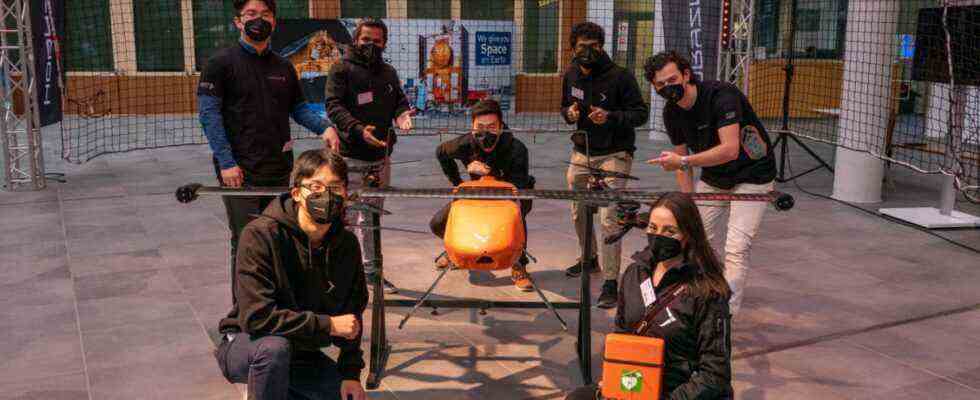The heart has stopped beating, now the patient lies motionless on the floor. A young woman kneels next to him and repeatedly presses the heels of her hands on his chest – but to no avail. What could still help to get the heart going again would be one or more electric shocks from a defibrillator. But where do you get such a device from? Suddenly rescue is approaching. From the air. From Frankenstein. This is the name given to the three by two meter drone that hovers in the air diagonally above the young woman. While the rotors whir softly, it drops an orange box on a rope. Inside: a defibrillator.
With its help, the young woman could now try to revive the person – if she were a real person. In fact, there is just a plastic doll on the floor. The young woman’s name is Sonja Dluhosch, is a student at the Technical University of Munich (TU) and is part of the Horyzn research initiative. Over the past two years, this group of around 70 students has developed a prototype of the lifesaver drone in their workshop on the research campus in Garching, which was recently presented to the public on the premises of the space company IABG in Ottobrunn – including a simulated rescue operation and in the presence by Bavaria’s Minister of Science Bernd Sibler (CSU).
“I am really impressed with the commitment of the Horyzn initiative,” he praised. “The project is a prime example of what students can achieve.” Sibler was convinced that the Horyzn drone will one day actually save lives – by getting the defibrillator to the scene faster than an ambulance can. According to the German Society for Cardiology (DGK), around 65,000 people in this country suffer sudden cardiac arrest every year – on average that is more than 175 per day. In more than 90 percent of the cases, this is fatal. According to the DGK, the chances of survival depend “essentially on how quickly and how well the first resuscitation measures are initiated”.
This is exactly where the students’ drone comes into play, which is primarily intended for use in rural areas, as Horyzn project manager Balázs Nagy said. He was convinced: “We can increase the chances of survival there because we are much faster than the ambulance.” In rural areas, it takes nine to fifteen minutes to get to the site. On the other hand, your drone, which is 120 kilometers per hour, can do this in four to five minutes – regardless of the road infrastructure.
The patient’s chances of survival should be tripled
“We cut the time by half and can thus triple the chances of survival,” said Balázs Nagy. He and the other students, who come from 30 countries and ten different TU faculties, have named the prototype of their drone Frankenstein – after Mary Shelley’s fictional character, who creates an artificial person in the laboratory. Unlike the researcher in the book, the young people in Garching “did not create a monster,” said State Chancellor Florian Herrmann (CSU) in a video message. “It’s a great development for the benefit of the people.”
He was particularly pleased that the lifesaver drone was created at the new TU Faculty for Aviation, Space Travel and Geodesy, emphasized Minister Sibler. Prime Minister Markus Söder announced its establishment in 2018, with its headquarters on the Ludwig-Bölkow-Campus in Taufkirchen and Ottobrunn – as part of a Bavarian space campaign. Söder received a lot of ridicule and criticism not only because of their initial name “Bavaria One”. The program is “not about observing Martians or sending people to the moon,” said Sibler in Ottobrunn. Rather, what emerges here is “performance in society”, as Faculty Director Mirko Hornung put it.
In the case of Horyzn, this power is an electrically operated wing drone with a wingspan of 2.50 meters, a weight of 20 kilos and ten rotors, with which the aircraft can fly forward as well as take off and land vertically. Once at the destination, Frankenstein goes into hovering flight before a box the size of a shoe box is lowered from a hatch on a rope. The orange box contains the defibrillator, which can also be used by medical laypeople in order to increase the chances of survival of the person concerned.
Currently, widespread use of the Horyzn drones is still a long way off. After completing their prototype, the students are now striving for the necessary certifications from the German and European aviation authorities. In the final stage – according to their plan – hundreds of lifesaving drones will then be stationed in rural areas and controlled remotely via a central control station. The alarm would be sent via the respective rescue control centers.

